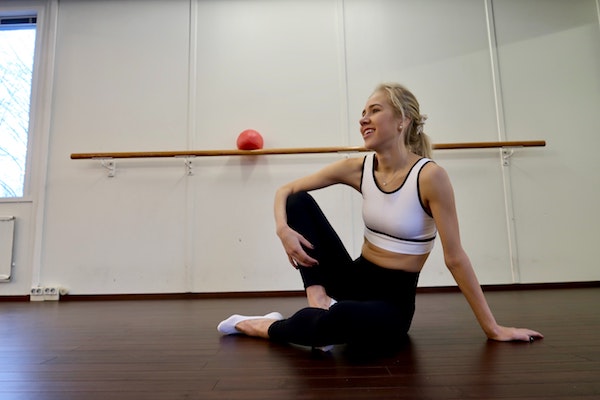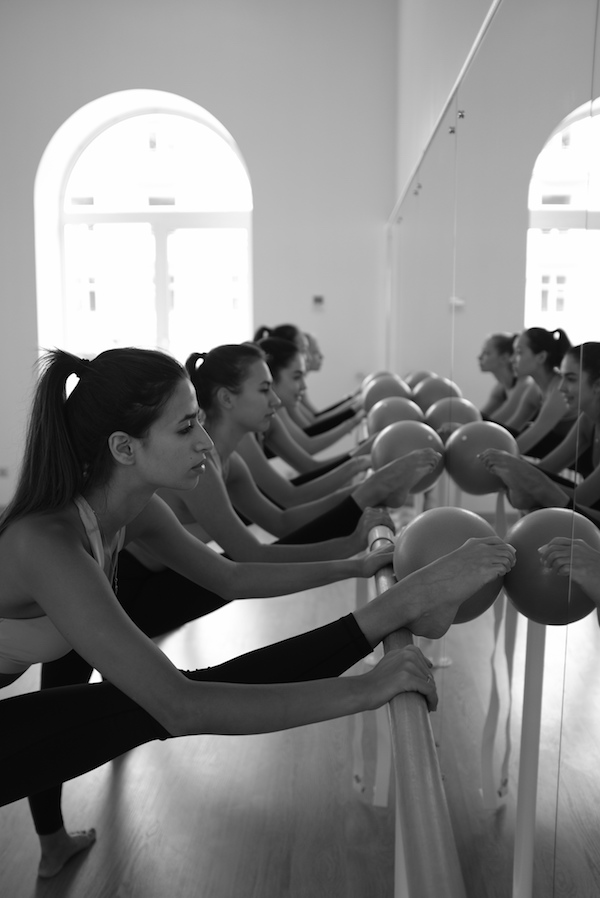
Move over pilates!
There’s a new fitness regimen in town called barre. It’s a ballet-inspired workout that challenges your muscles through small, controlled movements like pulses and pliés.
Although you won’t be moving your muscles much, you’ll still feel the burn. Barre moves are designed to target muscles you don’t often use and work them to fatigue by performing lots of repetitions.
Barre classes also incorporate equipment like light hand weights and pilates balls to add a little extra challenge to the workout.
But is barre the most effective way to build muscle, or are other forms of strength training better? What are the pros and cons of barre workouts?
Overall, barre has some tremendous health and fitness benefits. Your flexibility, balance, and core strength will explode with regular practice and workouts. Barre is also a safe form of exercise if you’ve had trouble with high-impact workouts and injuries before.
However, you won’t get a ton of cardio and conditioning work with barre, and there are better ways to burn calories for weight loss. Your strength and muscle gains will also plateau quickly as barre doesn’t include heavy resistance training — though with the right diet you could develop exceptional muscle tone over time.
Let’s dive in a little deeper to some of the benefits and drawbacks of choosing barre.
Pros of Barre Workouts
Barre studios are popping up everywhere, but is this workout regimen worth the hype?
Read on to find out about the pros and cons of barre workouts and decide for yourself.
Low-impact
Other dance-inspired workouts like Zumba are high-impact and hard on the joints.
But barre is actually great for people with joint problems because it focuses on slow, controlled movements rather than fast, dynamic ones.
Most barre exercises require you to hold your muscles in place or move them just a few inches at a time, which places very little stress on your joints.
So even if you have limited range of motion due to arthritis or an injury, you may still be able to take a barre class.
Strengthens underutilized muscles
Because barre exercises involve small, slow movements, they may seem like they won’t challenge or strengthen your muscles.
But barre moves are actually great at toning underutilized muscles that other workouts often miss.
Weight training and running tend to target fast-twitch muscles, which contribute to power and speed.
But if you want to be a well-rounded athlete, working your slow-twitch muscles is also important—and taking a barre class is a great way to do it.
Slow-twitch muscles improve your endurance and stabilize your joints. Strengthening them will help prevent injury and increase your stamina, making it easier to run long distances or finish a tough workout.
The best way to build up your slow-twitch muscles is to perform a lot of repetitions of small movements, which is what barre workouts are all about.
Increases your core strength
Although barre workouts can help tone your thighs, glutes, back, and arms, they’re best for strengthening your core.
Almost every barre move requires you to engage your core to keep your muscles steady while you’re pulsing them or holding them in place.
There are also barre exercises specifically designed to tone your abs, which will help get you closer to that sculpted look you’re after:
- Side Bends—an exercise that involves standing with your feet spread apart and lifting your arms up over your head while you bend from side to side. It’s great for engaging your core and increasing your flexibility, too.
- Scissors—a move that involves drawing one leg towards your chest while keeping the other extended in front of you, which will make your core burn.
Improves flexibility and balance
Another benefit of working out at the ballet bar is that you’ll see improvements in your flexibility.
Most classes incorporate 15 to 20 minutes of gentle stretching to help you warm up your muscles.
One common stretch is the Ice Skater. It involves placing both hands on the bar and balancing on one leg as you stretch the other one out behind you.
For an extra challenge, you can even pulse the extended leg.
Not only do stretches like this one increase your flexibility, but they also improve your balance.
Balance is important for athletes because it reduces your risk of injury and increases your agility.
So if you haven’t already, you may want to start taking barre classes to improve your coordination and athletic performance.
Cons of Barre Workouts

Barre exercises can improve your flexibility and strengthen your slow-twitch muscles.
But before you sign up for your first class, there are some downsides to this workout regimen that you should know about.
Hard to do at home
Most barre exercises like pliés and relevés are done at the ballet bar. So if you don’t have one, you may find it hard to do this workout at home.
You can buy a ballet bar for your home gym, but it will cost you between $100 and $200.
Most barre classes also use additional equipment like pilates balls, exercise mats, small hand weights, and resistance bands.
So if you want to fully kit out your gym, it could get expensive.
If you don’t have the money to outfit your home gym, you may be able to use the back of a chair as a replacement for the ballet bar.
You can also find barre-inspired workouts online that are designed to be done at home without any special equipment, but they won’t be the same as the classes you take at the gym.
Classes are expensive
Although buying barre equipment for your home gym can get expensive, taking classes at your local studio is costly too.
The average class costs between $20 and $40. So if you want to go a few times a week, you could end up spending a couple hundred dollars on barre classes every month.
Some barre studios offer discounts if you buy a monthly or yearly membership, however. So if you love your first barre class and want to make it a regular part of your fitness routine, consider buying an annual pass to save money.
You’ll still need to weight train
Another downside of barre classes is that they don’t replace weight training, unless you’re just starting out with fitness.
The light weights used in barre classes may be enough to challenge you and help you build muscle if you’re a fitness novice.
But as you get stronger, those small hand weights won’t put enough load on your muscles for you to continue to make gains.
So after a few weeks of barre classes, you’ll have to incorporate heavier weights into your workout routine if you want to keep building muscle.
No cardio
Although barre classes are challenging, they don’t get your heart rate up high enough to be considered cardio.
Because barre movements are so slow and controlled, they’ll only raise your heart rate to about 40% or 50% of its maximum.
Some barre classes incorporate aerobic moves like mountain climbers to get your heart rate up. But they won’t condition your body as much as high-intensity cardio workouts like running or cycling.
So if your main goal is to burn lots of calories or improve your cardiovascular fitness, barre workouts may not be the best choice.
Wrapping Up
Barre is a beginner-friendly fitness regimen that can help you tone your muscles without putting stress on your joints.
The small, controlled movements involved in most barre exercises are great for targeting your small-twitch muscle fibers, which are responsible for endurance.
Taking a barre class is also a great way to increase your flexibility and balance.
But because barre classes only incorporate light weights, resistance bands, and bodyweight moves, there’s a limit to how much strength you’ll gain from barre classes alone.
They aren’t the best way to improve cardiovascular fitness either because they don’t get your heart rate up high enough.
Despite these drawbacks, barre workouts are still a great addition to your fitness routine—they just won’t take the place of your regular weight training or cardio sessions.
Learn more about what barre results you can expect after committing to regular workouts, and some tips for your first barre class here.
Still not sure which workout is right for you? Check out all of my articles for beginners who are looking to just get started.